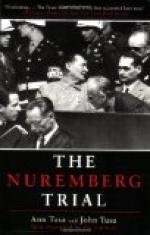|
This section contains 269 words (approx. 1 page at 300 words per page) |

|
The press, the German people, and the general public were all able to watch the trial. The transcripts and documents were also available, so no one could accuse the Allies of misconduct. The trial was universally recognized and respected. Nevertheless, the Nuremberg Trial was an imperfect tribunal, but it was still more just by legal standards than perhaps any other created to adjudicate war crimes. The fairness of the trial was evident in the fact that three of the defendants (Schacht, von Papen, and Fritzsche) were acquitted. Still, the evidence was so overwhelming that eleven were given the death penalty, three were sentenced to life imprisonment, and four received prison terms ranging from ten to twenty years. Those who received prison sentences were sent to Spandau Prison. Those acquitted were placed in a denazification program following the trial.
After 1966 the sole inmate of...
|
This section contains 269 words (approx. 1 page at 300 words per page) |

|




